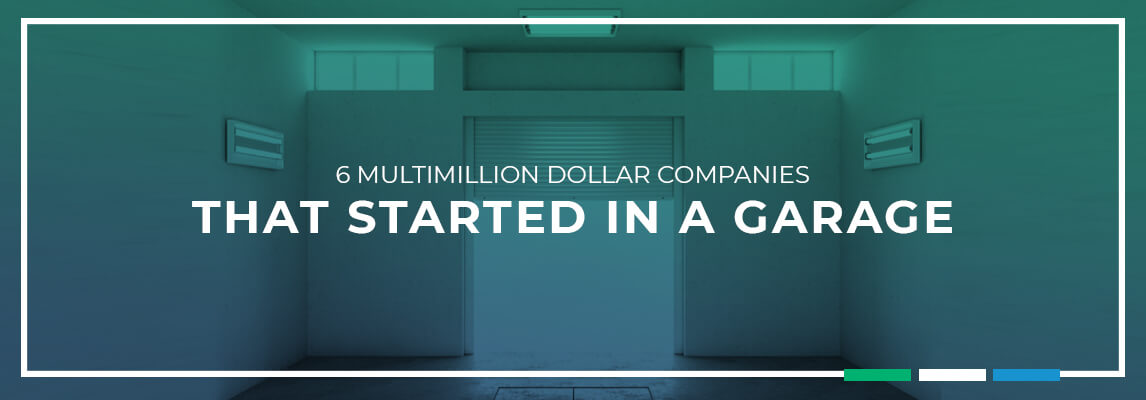
When you think of the uses of a garage, what comes to mind? Do you think of a place to store your car, or space where you save the pool floaties, bicycles and soccer balls from the hot sun? Or maybe it’s the part of your home that opens up to welcome you after a taxing day at the office? Whatever you think of when you think of your garage, most people don’t realize that a garage can hold much more than cars or plastic holiday decorations.
It can hold hopes, dreams, ideas and innovations too!
Garages offer much more than storage space. They also offer the solitude and support necessary to turn ideas into industries. From the 1920s to today, passionate future-billionaires of all generations took to the inside of their garages to flesh out ideas that would change the world forever, giving the term “working from home” a whole new meaning.
The humble beginnings of the following six companies that started small and made it big prove that it doesn’t take big buildings to make big dreams a reality. Sometimes, a sturdy garage and a hint of inspiration are all you need.
Table of Contents
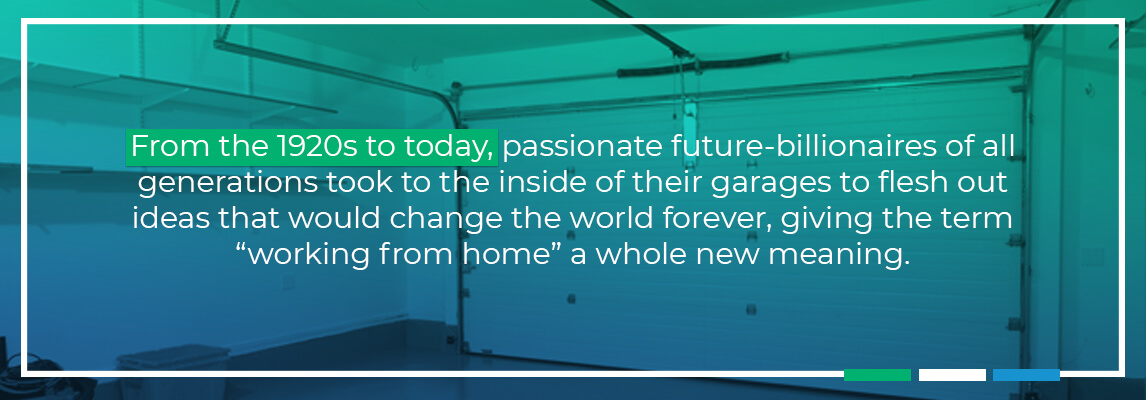
1. Google
Sometimes people just click. You share a smile and a witty remark, and you know you’ll be friends for a long time to come.
That wasn’t the case for Larry Page and Sergey Brin.
When the two first met, they never would have guessed they would end up working together on any project, much less one that would change the Internet as they knew it and impact online users for the next 20 years. But what started as a small dorm room collaboration turned into a slightly larger garage partnership. And from there, well, the rest is history.
Google’s History
Sergey Brin was a bubbly second-year grad school student at Stanford University studying computer science. He had volunteered to show potential first-year students around the campus and the surrounding San Francisco area. It just so happened that Larry Page, a prospective engineering student from East Lansing, Mich., ended up in Brin’s group.
An unusual combination, since the two could barely stand each other.
They butted heads about everything, debating about even the most mundane topics as urban planning. But they grew to understand and even like each other, which caused Brin to hop on board with Page’s thesis topic in 1995 — a reverse engineering of the World Wide Web that counted and qualified online links and pulled the information into an easily accessible portal. Page called the project BackRub.
The two started their research in Page’s dorm room, where they renamed the site Google and spent three years perfecting the idea. Google caught the eye of surrounding Silicon Valley investors such as Sun co-founder Andy Bechtolsheim, who wrote them a check for $100,000 in 1998.
![]()
What did Page and Brin do with the check? They invested in their first real office — a garage rented from friend Susan Wojcicki.
Google Today
Google eventually outgrew that original office. The company moved its main headquarters to the Googleplex in 2004 and accumulated over 70 other offices in 50 countries. It’s no wonder — Google needs all the space it can get to hold its 60,000 employees.
Today Google hosts over 40,000 searches every second, making the industry giant the most popular search engine in the world. It owns mega-popular products such as Android smartphones, Gmail and YouTube — whose CEO, Susan Wojcicki, provided Google with their garage headquarters 20 years ago.
2. Apple
The number one most profitable Fortune 500 company, it can be hard to fathom just how massive an empire the makers of Apple created for themselves. Students, businesspeople and celebrities alike sport iPhones everywhere they go, and product placement for Apple’s products can be seen in movies, TV shows and music videos worldwide.
But Apple founder Steve Jobs wasn’t always a successful billionaire. At one time, he was a college dropout with empty garage space and a dream that changed the world.
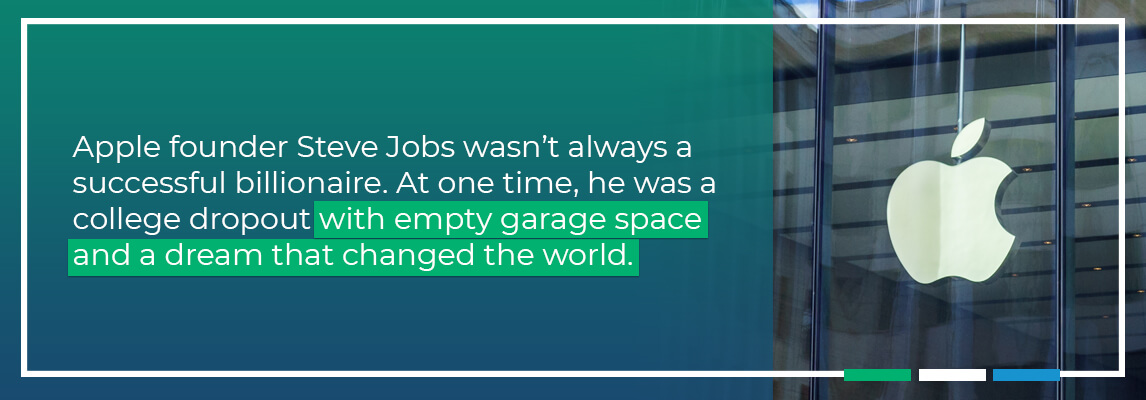
Apple’s History
Steve Jobs’ childhood home housed Jobs, his sister Patricia and their adoptive parents Paul and Clara since Jobs’ seventh-grade year of school. After dropping out of Reed College at age 21, Jobs began using the house’s garage as a hang-out spot with friends Steve Wozniak and Ronald Wayne.
Jobs and Wayne met while working at Atari, while “Woz,” a fellow college dropout, worked at Hewlett-Packard. The three friends started development of the first Apple computer in their free time in 1975.
In early 1976, the men officially founded Apple Computers with $1,300 that Woz raised himself. Production continued from Jobs’ parents’ home, where they built around 200 Apple I units that they sold without monitors, keyboards, cases or power supplies.
And while the company itself didn’t work out of the garage quite as often as the popular myth suggests, its comfort still provided the trio with a recreational space and a place to tune up and store their products.
Wayne sold his share of the business for just $800 three months after the company’s establishment for fear of its failure, but the two Steves continued their quest for glory as Apple slowly picked up popularity with computer users.
Apple Today
After Woz left Apple in 1985 to pursue goals more closely related to his field, Jobs took over as the head of the company. He used the growing success of the Apple II to mold Apple into the massively thriving enterprise we see today.
Jobs was the revolutionary leader of the iMac, iPod, iTunes, MacBook, iPhone and iPad, the first popular products of their kind. At the time of Jobs’ death in 2011, Apple was generating $110 billion of annual revenue.
The new CEO, Tim Cook, continued to follow in Jobs’ footsteps, unveiling the Apple Watch, Apple Music and revolutionary new iPhone technology. Now, Apple boasts a record revenue of $61.1 billion per quarter, with 80,000 official Apple employees and a campus costing $5 billion.
3. Microsoft
If you’re reading this article on a computer, chances are you’re using a type of Microsoft product. In fact, Microsoft’s Windows operating systems account for over 44 percent of all recent government website traffic — in second place at almost half that is iOS with 26 percent. But even many Apple users use Microsoft speakers, mouses, keyboards or the popular Microsoft Office software.
All this success wouldn’t have been made possible without the hard work that founder Bill Gates put into his computer education or the New Mexico garage where it all began.
Microsoft’s History
Gates and friend Paul Allen taught themselves computer code in middle school. In the 1960s, access to computers was still limited.
But Gates and Allen envisioned a world of technology. Throughout high school, they made deals with various computer companies to provide them unlimited computer access in exchange for improving bugs in the computers.
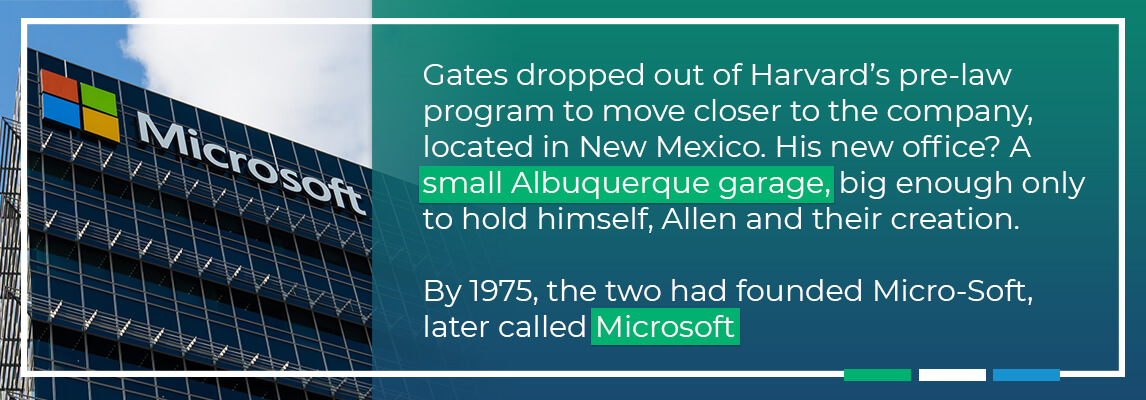
In college, Gates’ passion for computers grew. He and Allen heard about a microcomputer developed by MITS and contacted the company about writing a programming language for the computer. Allen was hired at MITS, while Gates dropped out of Harvard’s pre-law program to move closer to the company, located in New Mexico.
His new office? A small Albuquerque garage, big enough only to hold himself, Allen and their creation.
By 1975, the two had founded Micro-Soft, later called Microsoft, which would grow to become the industry giant we know today.
Microsoft Today
Microsoft has become a leader and innovator in the world of technology. While Allen left the company in 1983 and Gates stepped down as Microsoft’s chairmen in 2014, the two men still hold massive wealth, worth $20 billion and $92.9 billion, respectively. Gates was the richest person in the world until 2017 and remains the second richest person in the world.
Today, Microsoft might own the most popular computer operating system in the world, but they’ll never forget their roots. The company introduced Microsoft Garage in 2014, a program designed to give employees space to work on new projects and developments, and a reminder that good ideas often come from small places.
4. Amazon
You may know Amazon.com as the online retailer giant, the major innovator of the e-reader and creator of the popular virtual assistant Amazon Alexa. You may even remember when the site was nothing more than an online bookstore. But you may not know the story behind that little virtual bookstore that took the world by storm. Particularly, you might have never realized that founder Jeff Bezos transformed his home garage into a full-time workspace.
Amazon’s History
A Princeton graduate, Bezos’ story doesn’t involve dropping out of school or rags-to-riches success. In fact, after his graduation in 1986, Bezos worked his way up the ranks of Wall Street firm D.E. Shaw & Co. At age 30, he enjoyed financial stability as the company’s youngest-ever senior vice president.
But money can’t always buy happiness. Wall Street may have seen Bezos as a successful businessman, but he felt personally unfulfilled.
In 1994, at the age of 30, Bezos and his wife MacKenzie packed up and moved across the country from the busy life of Wall Street to a quiet neighborhood in Bellevue, Washington, 15 minutes from Seattle. Fascinated with the rapid growth of the Internet, Bezos was determined to develop his own online retailer and set up shop in the garage of his rental home to begin an online bookstore.
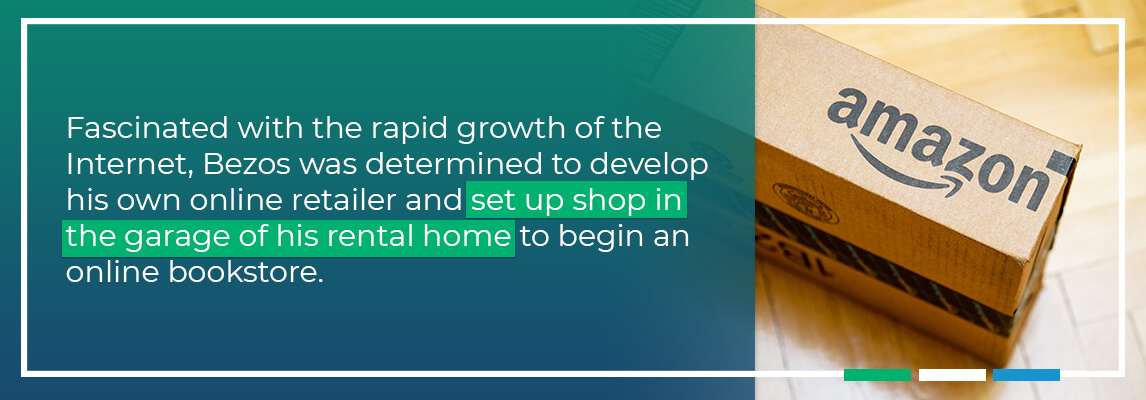
A year later, Amazon.com launched in July 1995 and sold its first book, “Fluid Concepts & Creative Analogies: Computer Models of the Fundamental Mechanisms of Thought.” Within the first month of its launch, it had sold books to people in all 50 states and 45 countries.
Amazon Today
Bezos and his team of five employees spent the business’ first year working out of his garage and holding business meetings at their local Barnes and Noble. But the home soon became too crowded to handle the massive number of orders placed daily worldwide. The company now employs over 563,000 full- and part-time workers, with 140 fulfillment centers spread across the United States.
Amazon continues to push the boundaries in online retail. It popularized e-readers with the launch of the Amazon Kindle in 2007 and now has its own TV and music streaming services. Recently, the Amazon Echo launched as the first voice-activated wireless speaker and personal assistant of its kind.
Long gone are Bezos’ garage days as he continues to enjoy massive success as the CEO of Amazon. With a $142 billion net worth, Bezos overtook Bill Gates as the richest person in the world in July 2017.
5. Disney
Self-starters of any era need a place to work on their passions uninterruptedly.
While many entrepreneurs of the latter half of the 20th century used garages for the beginnings of their unprecedented success, one of the most famous examples of garage startups that flourished into greatness dates back to the early 1920s. In 1923, Walt Disney began what would become a mass media and entertainment conglomerate in his uncle Robert’s small wooden garage.
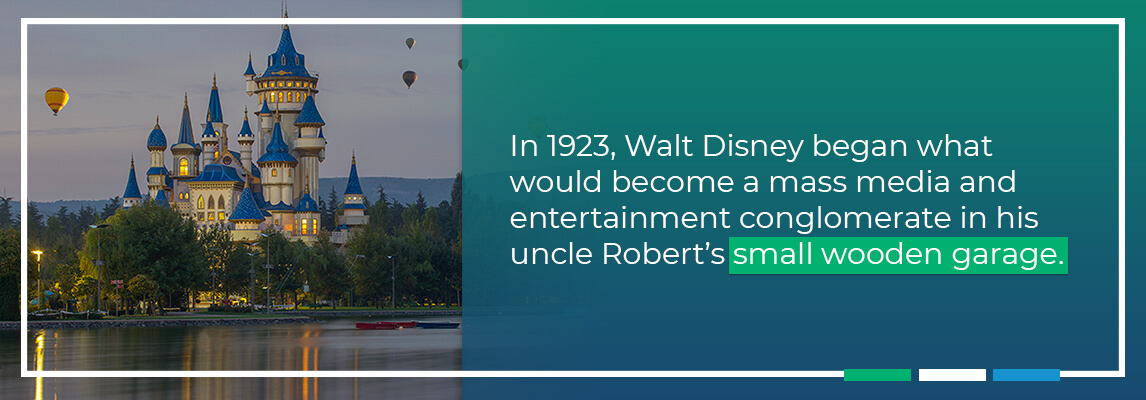
Disney’s History
Disney had been interested in cartoon drawing since his youth. He got a job in 1919 creating commercials using cutout animations, and he had found small success with his own animation business’ cartoon “Laugh-O-Grams” until its bankruptcy.
At the age of 22, Disney moved from Kansas City,Missouri, to his uncle’s Kingswell Avenue cottage in Los Angeles. With the growing Hollywood film industry, Disney hoped he could find success for his animations, despite his first failure. He and his brother Roy combined Walt’s love of drawing with Roy’s business skills to form a new animation company that wouldn’t drown in debt. They began production on their first project, “Alice Comedies,” with just an animation stand and a camera tucked away inside the grey swing-out doors of his uncle’s garage.
This garage became the first Disney studio.
Disney Today
Disney achieved success far beyond what he dreamed of. Today, Disney is one of the biggest media conglomerates in the world. Appearing at number eight on Forbes’ list of most powerful brands with a brand value of $47.5 billion, The Walt Disney Company is a recognized and trusted source of media and entertainment for families worldwide.
There’s not much Disney doesn’t do in the world of entertainment. The Walt Disney Company dominates the industry. It owns Walt Disney Animation Studios, The Muppets Studio, Pixar, Marvel and Lucasfilm as part of its film studio empire. Walt Disney Parks and Resorts oversees Disneyland Park and the Walt Disney World Resort. In the television industry, Disney operates Disney Channel, ABC, part of Hulu, ESPN and A&E Networks. Musically, the company owns Hollywood Records and Radio Disney.
6. Hewlett-Packard
Another old-school garage start-up story, it seems hard to believe that HP was founded almost 80 years ago or that the company began with only $500 in a 12-by-18-foot garage in Palo Alto, California. But coming out of the Great Depression, Bill Hewlett and Dave Packard had little money to their names and knew it would take a lot of work to make it big in the world of technology.
HP’s History
After graduating as engineering students from Stanford University, Hewlett and Packard became close friends on a camping trip and decided to start their own joint venture. With $538 worth of cash and a used drill press, the two created their first product — an audio oscillator that was used to test sound equipment — in 1938 out of a garage they rented for a workspace.
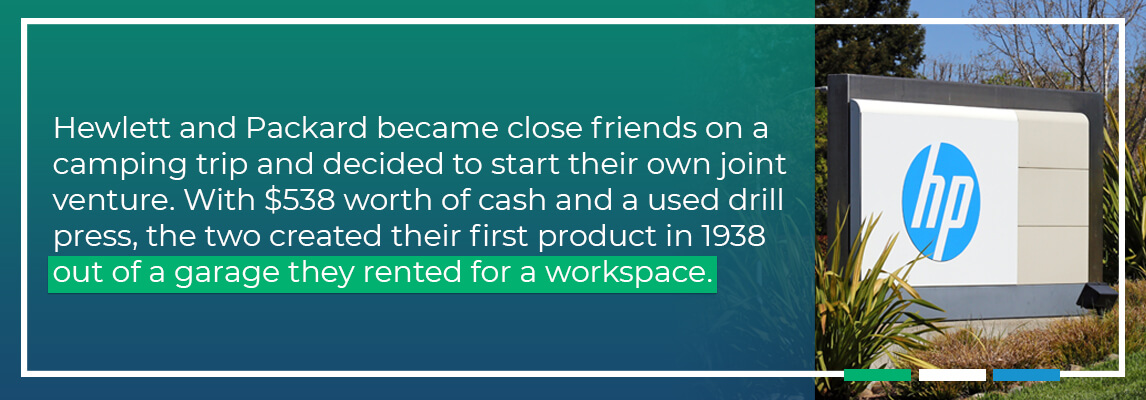
The garage had nothing more than a concrete floor and a workbench, but the pair’s big dreams equipped it to lead the way in technological innovation.
HP got its big break with one of its first customers, which was none other than Walt Disney Productions. Walt Disney saw potential in the two young workers and asked for eight of their oscillators to improve audio production on his film “Fantasia.”
Continuing production from the rented garage that served as their first office until 1940, Hewlett and Packard produced electronic testing equipment and medical technology before launching into the business of computer technology we know them for today.
HP Today
When Hewlett and Packard first launched their company from that Palo Alto garage, they had no idea what impact their decision would have on the surrounding region. At the time, the area was an agricultural district consisting of fields and farms. But the duo’s success turned it into a hub of innovation and technology, and you can thank their success for what we know today as Silicon Valley.
The garage, turned into a private museum, remains one of the most famous Silicon Valley attractions. The small Addison Avenue workspace is now a historic landmark, known as the “Birthplace of Silicon Valley.”
As for the company itself, HP continues to leave a lasting impact in the field of computers, laptops, printers and other technological accessories. It was the world’s largest PC manufacturer in 2017 and holds a place as one of Forbes’ Most Valuable Brands, ranking at number 50 on the 2018 list.
Why Use a Garage?
The success of multi-billionaires like Jeff Bezos and Bill Gates doesn’t lie in where they produced their products. These were just people with good ideas who had the knowledge, time and willpower to chisel away at their passions.

The garage doesn’t magically turn dreams into reality. But the solitude and homey feel of a garage might have been just what these entrepreneurs needed to give them a little extra push in the right direction.
These self-starters realized some of the best benefits that come from turning your garage into your workspace. You may never have realized that working from a quiet space such as a garage allows you to:
- Focus: When you’re working from home, it can be hard to concentrate on any type of project. In a garage, unlike other parts of your home, loud noises from family members and pets won’t be as much of a distraction.
- Set your own schedule: No more forgetting sudden three-in-the-morning rushes of inspiration. With the quiet space that the garage provides, you don’t have to worry about waking up your family with late-night work. You can set your own hours, day or night.
- Relax: Working from home while not working directly in your home gives you the balance you need between spending time with family and distancing yourself from any distractions. At the end of the day, you don’t want to take your work home with you. Working from the garage allows you the opportunity to keep your work at home while still distinctly separate from your home life.
If you’re looking for a perfect office space where your next big idea can strike, the garage can be just the start you need. It’s often one of the most overlooked parts of your home, but it can help you achieve great things.
Whether you want to turn your garage into your new office or just need a space to store those pesky pool noodles, contact Banko Overhead Doors today to help you update your garage door. We service the Tampa Bay area and surrounding communities to provide the best garage door that will fit your needs.











